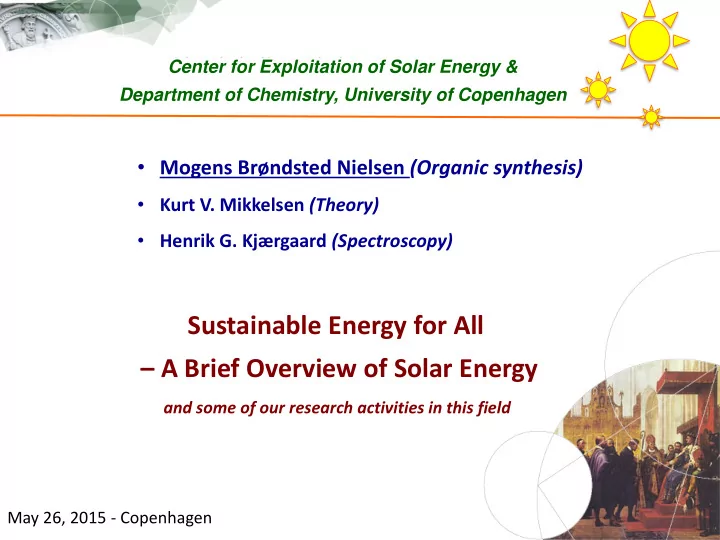

Center for Exploitation of Solar Energy & Department of Chemistry, University of Copenhagen • Mogens Brøndsted Nielsen (Organic synthesis) • Kurt V. Mikkelsen (Theory) • Henrik G. Kjærgaard (Spectroscopy) Sustainable Energy for All – A Brief Overview of Solar Energy and some of our research activities in this field May 26, 2015 - Copenhagen
Annual global energy demand … is expected to increase by a factor of 1.5 from 2007 to 2035 Challenges • Ready access to sustainable energy sources all over the world for cooking, heating, etc. • Economic growth equitable and addressing growing energy demand • Reduction of global emissions
Challenges • Ready access to sustainable energy sources all over the world for cooking, heating, etc. • Economic growth equitable and addressing growing energy demand Sunlight … is the the most abundant carbon-neutral energy source available on Earth. The amount of energy from the sun hitting Earth in 1 hour is more than the total global consumption of energy in one year! • Reduction of global emissions Can we use closed energy cycles with no emissions of CO 2 or other pollutants?
Uses of Sunlight capture – conversion – storage • Photovoltaics : Direct conversion into electricity • Concentrated solar power: Large beams of sunlight are focused into a small beam using mirrors or lenses. Heat transfer fluid systems, for example to drive steam turbines … or for water heating • Photocatalysis – for example conversion of water into hydrogen and oxygen or synthesis of other solar fuels. Combustion of H 2 produces only H 2 O (carbon-neutral method of storing solar energy). Storage of H 2 gas is a major challenge (one method is as solid hydrides) and maybe better to store the solar energy directly as batteries (?) Solar powered hot water systems utilize solar energy to heat water. In certain areas, 60 to 70% of water used domestically for temperatures as high as 60 o C can be made available by solar heating.
Solar Energy – Advantages Many different purposes: It can be used to generate electricity in places that lack a grid connection, for distilling water in Africa, or to power satellites. Building materials: With flexible thin-film solar cells, solar power may be integrated into the material of buildings No over-consumption: Solar energy is sustainable - there is no way we can over-consume. No pollution: Harnessing solar energy does generally not cause pollution. However, there are emissions associated with the manufacturing, transportation and installation. Availability: Solar energy is available all over the world. Low Maintenance: Most solar power systems do not require a lot of maintenance. Silent : No noise associated with photovoltaics.
Solar Energy – Drawbacks Space: The global mean power density for solar radiation is more than any other renewable energy source, but not comparable to oil, gas and nuclear power. Pollution: Some manufacturing processes are associated with greenhouse gas emissions. Exotic materials: Certain solar cells require materials that are expensive and rare in nature, either cadmium telluride (CdTe) or copper indium gallium selenide (CIGS). Cost: Average cost per kWh is a factor of 2-3 higher than other sources Intermittent energy source: Access to sunlight is limited at certain times. However, solar power has fewer problems than wind power in this regard. Storage: mismatch of supply and demand
How is the energy stored? When you speak of the sun, it shines. Then I don’t understand why we don’t speak about it! - Storm P. Robert Storm Petersen (1882-1946; Danish cartoonist, painter and humorist)
Molecular Photoswitches / Photochromic Molecules Cis-trans isomerizations Electrocyclic reactions … changes in molecular structure upon irradiation
Energy Storage using Photochromic Molecules – Closed Energy Cycle with No CO 2 Emissions or Other Pollutants Light absorption – Storage – Energy release on demand determines storage time
Challenges • How do we design photochromic molecules with sufficiently high energy densities? • How is the energy-releasing back-reaction put on stand-by? … energy storage How do we avoid photodegradation of molecules over many cycles? • …
… Material with energy density of 1 MJ / kg • Heat release of 1 MJ can be used to bring 3 L of water from room temperature to the boiling point • Harvesting light during the day and releasing heat during the night: - maintaining 1 m 3 at 19 o C with outside temperature of -6 o C requires ca. 3 kg of solar thermal battery (when using foam insulation) T. R. Kucharski, Y. Tian, S. Akbulatov, R. Boulatov, Energy Environ. Sci. 2011 , 4 , 4449-4472. Compare: Li ion batterier < 1 MJ / kg
Another Candidate Molecule: Dihydroazulene (DHA) Energy storage: 0.11 MJ / kg … We need to modify the molecule to increase this value!
DHA Synthesis … Easy to do M. Brøndsted Nielsen and co-workers
Energy Storage Substitute one CN for a H 0.11 MJ / kg 0.25 MJ / kg 0.15 MJ / kg 0.23 MJ / kg By minor structural variations we have recently doubled the energy density! S.T. Olsen, J. Elm, F.E. Storm, A.N. Gejl, A.S. Hansen, M.H. Hansen, J.R. Nikolajsen, M.B. Nielsen, H.G. Kjaergaard, K.V. Mikkelsen, J. Phys. Chem. A 2015 , 119 , 896-904. M. Cacciarini, A.B. Skov, M. Jevric, A.S. Hansen, J. Elm, H.G. Kjaergaard, K.V. Mikkelsen, M.B. Nielsen, Chem. Eur. J. 2015 , 21 , 7454-7461.
Halting the Energy-Releasing Back-Reaction … We are currently working on triggering the energy release by a catalyst Chem. Eur. J. 2015 , 21 , 7454-7461.
The Other Extreme: A Very Fast Photoswitch Light-Harvesting followed by Immediate Energy Release EurJOC , In press.
Molecules with Two or More Photochromic Units Energy Chem. Eur. J. 2015 , 21 , 3968-3977.
Center for Exploitation of Solar Energy & Department of Chemistry, University of Copenhagen Thank you!
Recommend
More recommend